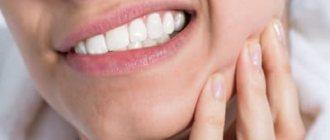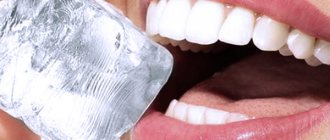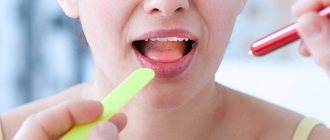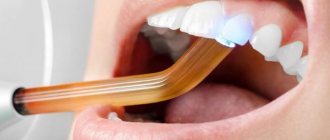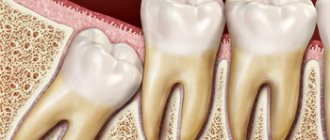Increased sensitivity of teeth (hyperesthesia) is a short-term occurrence of pain under the influence of temperature, chemical or mechanical irritating factors. Usually occurs when drinking cold water, sour, sweet, salty, or touching with a toothbrush. The intensity of pain varies from mild to unbearable.
According to WHO, every second person in the world suffers from hypersensitivity. In Russia it is about the same: 45–65% of adults aged 20–55 years. More often women make complaints.
A little anatomy
A tooth consists of a crown and root part, connected by a neck. The coronal part is covered with enamel, the root part is covered with cement. Beneath the enamel and cement there is dentin, a hard tissue. Inside there is soft tissue - the pulp; blood vessels and nerves pass through it.
Dentin is not sensitive, but consists of many tubules in which fluid circulates. The irritant causes fluid movement, which is detected by the nerve endings of the pulp. A person feels their reaction as pain.
Tooth sensitivity: causes
- Demineralization of enamel. It becomes more loose due to the leaching of calcium, phosphorus, and other trace elements.
- Thinning of enamel. As a result of increased abrasion due to malocclusion and the occurrence of wedge-shaped defects.
- Untreated caries or violation of the marginal seal of the filling.
- Exposure of roots as a result of injury, metabolic-dystrophic process or inflammation of the gums.
- Changes in the pH of saliva due to the consumption of certain drinks, foods, and medications. A pH of less than 5.5 is considered dangerous.
- Some diseases accompanied by gastroesophageal reflux and endocrine disorders.
- Vitamin deficiency, exposure to radiation, work in hazardous industries, living in a region with an unfavorable environmental situation.
- Smoking.
More often than not, several reasons are discovered at once. The enamel becomes thinner, loses strength, and cannot protect dentin from irritants. The result is pain.
Why does hot toothache hurt?
A hot tooth may hurt due to the expansion of the lumen of the dentinal tubule, the movement of fluid from the pulp to fill the new volume and thereby irritate the same process of the odontoblast. But expansion is not as critical as compression, so 3 times fewer patients experience increased sensitivity from heat. Similar to pain from cold, a quick reaction to hot may indicate the presence of caries or a wedge-shaped defect, longer pain may indicate pulpitis.
A pulpless tooth may hurt from heat. In acute periodontitis (or exacerbation of chronic), swelling of the peri-radicular tissues occurs, heating increases the swelling, the pressure in the cyst cavity increases - the pain intensifies. Cold in such a situation, on the contrary, alleviates suffering.
Provoking factors
Hyperesthesia does not appear immediately. There are several factors that you need to pay attention to in order to eliminate them in time. Don't wait for discomfort to appear. It is better to initially develop healthy habits that will help you maintain your health so that you never experience acute dental pain. Sensitivity increases when any of the factors listed below are present.
- Insufficient oral hygiene. Soft plaque is an accumulation of microbes that eat food microparticles stuck in crevices, releasing organic acids that dissolve enamel minerals. Externally, the dental unit looks intact, but the density of the enamel is significantly reduced. Its demineralization occurs. The first alarm bell is increased sensitivity, then caries develops.
- Consumption of certain foods. Juices, wine, sweet soda, fruits, candies, and other sweets contain phosphoric and other acids that negatively affect the strength of enamel.
- Constant use of aggressive whitening pastes containing abrasive and chemical components.
- Ultrasonic cleaning. Under a dense coating, the enamel becomes thinner and becomes loose. After professional cleaning, it is exposed, its sensitivity increases sharply. Usually, dentists, taking this point into account, use strengthening pastes at the end of the procedure for the preventive treatment of tooth sensitivity.
Pain after dental treatment (installation of a filling or crown)
It happens that the first few days after treatment, the tooth reacts to the cold with a feeling of discomfort or even pain. This is a normal reaction. As soon as the inflammatory processes caused by caries and medical manipulations pass in the tooth, the symptoms will disappear on their own. If increased sensitivity to the temperature of food and drink occurs 1-2 weeks after treatment, then this is a sign of an increasing inflammatory process in the treated tooth. If you notice that your tooth hurts from cold or hot weather, you should schedule a visit to the dentist as soon as possible.
Types of hypersensitivity
If sensitivity is increased on one or more teeth, it is called limited. If for everyone - generalized.
Table 1. Types of hyperesthesia
| № | View | Reaction |
| 1. | Light | for cold, hot |
| 2. | Average | as with 1st degree plus for sour, sweet, salty |
| 3. | Expressed | as in grade 2 plus mechanical irritants (when brushing teeth, eating) |
Why does sweet tooth hurt?
For the same reason as from salty water - the osmotic pressure of the sucrose solution draws fluid from the dentinal tubules. Sweet flour foods have an increased degree of adhesion to the tooth surface. Therefore, the pain from sticking candy will last longer than from a pickled cucumber.
As with cold, a short pain reaction most often indicates caries or a wedge-shaped defect, a long-lasting one indicates pulpitis.
A pulpless tooth cannot hurt from sweets.
Sensitivity of teeth. Stages of treatment
- Eliminate the cause of hyperesthesia: get rid of plaque, deposits, stones, caries, wedge-shaped defects.
- Carry out professional oral hygiene.
- Strengthen the enamel with calcium and fluoride.
- Teach the patient how to use a toothbrush and floss correctly.
- Choose suitable dental care products: toothpaste, mouthwash.
Table 2. Tooth sensitivity: causes and how to treat
| № | Cause | What to do |
| 1. | Soft coating. | Careful hygiene with home remedies. |
| 2. | Hard coating. | Professional hygiene in dentistry. |
| 3. | Caries in the white spot stage. | Deep fluoridation, remineralization. |
| 4. | Caries, pulpitis, periodontitis. | Dental treatment. |
| 5. | Exposure of the cervical part, wedge-shaped defect. | |
| 6. | Malocclusion. | Orthodontic therapy. |
What complications may arise?
The main thing to remember is that tooth sensitivity does not go away on its own. If you do not fight it, the disease will progress quickly. Unpleasant sensations will soon be replaced by outbreaks of pain when the enamel is irritated by hot and cold drinks. Then you will not be able to eat sweet and sour, salty and spicy. And at the last stage, short-term pain transforms into constant pain, and its intensity will be such that just touching the tooth will seem unbearable.
At the last stage of the disease, fluoridation will no longer help. It will be lucky if the dentist agrees to cover the patient’s own enamel with composite materials. But in most cases, the doctor will insist on the removal of diseased teeth and subsequent prosthetics.
Elimination of tooth sensitivity
Using ultrasound, the doctor removes soft and hard deposits from the teeth. After removing plaque, teeth become more sensitive for a short time, so remineralization or deep fluoridation is immediately carried out. During remineralization, the enamel is treated with active compounds of calcium and phosphates. Deep fluoridation – coating with sodium fluoride. Both procedures significantly strengthen the enamel's resistance to irritants.
The doctor uses agents that reduce the movement of fluid in the dentinal tubules. It “seals” them using desensitizers or reduces their volume through remineralization. Protecting exposed dentin reduces the force of transmission of the irritant impulse from the enamel to the nerve.
Treatment in dentistry
A doctor has many ways to overcome hyperesthesia. First of all, the dentist will try to identify the problem of his profile: periodontal disease, caries, non-carious enamel lesions. If there are any, the patient will have to treat the detected pathologies.
If the teeth are healthy, and the patient complains of pain from hot foods, the dentist will recommend contacting a therapist, and then specialists to identify the causes of the problem. And to improve the quality of life, it will seal the dentinal tubules with remineralizing agents, sealants, and desensitizers.
Basic points of proper hygiene
Use a synthetic, medium-hard or soft brush. Change it every three months.
The toothpaste should be suitable for very sensitive teeth. Typically, such products contain hydroxyapatite, strontium chloride, fluorides, potassium nitrate, or a combination of calcium carbonate and arginine.
Take enough paste. For children under 3 years old - the size of a grain of rice, from 3 to 14 years old - the size of a pea, for adults you need to squeeze out about one centimeter.
Brush your teeth for 2 minutes: 30 seconds on each surface, top and bottom. Monitor time using an hourglass or mobile phone timer. Electric toothbrushes emit a short beep every 30 seconds and a long beep every 2 minutes from the start of brushing.
Cleaning sequence
- Using sweeping movements, clean the outer and then the inner surfaces of the bottom row. Move from molars to incisors. Then do the same on the top row. Hold the brush at a 45-degree angle and do not use a sawing motion. This leads to damage to the enamel.
- Brush chewing surfaces with small circular movements.
- Close your jaws and walk along your gums in a circular motion.
- Brush your tongue using a leisurely four to five strokes from root to tip.
- Treat the interdental spaces with dental floss.
- Rinse your mouth.
It is more effective to clean with an electric brush or irrigator. The quality of hygiene increases 3–4 times. Hyperesthesia can be dealt with faster.
Is it possible to strengthen sensitive teeth at home?
Yes. If you can’t get to the dentist, you can try to help yourself. There are several remedies that can solve the problem of hyperesthesia at home.
Table 3. Popular products for home use
| № | Name | Mechanism of action | Age category |
| 1. | ROCS Medical Minerals, GC Tooth Mousse | Remineralizing gels | Adults and children |
| 2. | Colgate Duraphat 2800 ppm | Fluoridating paste | 10–15 years |
| 3. | Colgate Duraphat 5000 ppm | From 16 years old | |
| 4. | ELMEX junior | Fluoridating paste | 6–12 years |
| 5. | ELMEX | From 13 years old | |
| 6. | LACALUT Extra Sensitive | Paste that reduces tooth sensitivity | For adults |
| 7. | Colgate Sensitive Pro-Relief | ||
| 8. | PRESIDENT Sensitive | ||
| 9. | LACALUT Sensitive, 300 ml | Rinse for sensitive enamel | From 15 years old |
Why does a tooth hurt after extraction?
Any significant injury to a living person causes pain. Tooth extraction (like any other operation) is a trauma, and it is quite natural that after the anesthesia wears off, the extracted tooth socket ache. This pain can be eliminated with analgesics. Ketorolac (ketanov, ketorol) is the most effective non-narcotic analgesic. But you can use it for no more than 5 days and no more than 4 tablets per day (every 6 hours). Rinsing with soda, salt and other caustic solutions is contraindicated.
After 3-4 days, postoperative swelling reaches its maximum, so pain may increase during this time. But then it should only decrease and disappear a week after removal.
If the pain remains or increases 4 days after removal, alveolitis has probably developed. You need to see a doctor for inspection of the hole (under anesthesia). Formation and preservation of a new blood clot is the best prevention of recurrent alveolitis and continued pain.
Algorithm of actions for hyperesthesia
- Adjust your diet. Avoid completely or significantly reduce the consumption of foods and drinks containing acids and sugar. Especially fruit and berry juices, wine, candies. Eat more green vegetables, fiber-rich foods, and whole grains.
- Change your toothpaste. Never use bleach. Choose from those labeled "Sensitive".
- Check if you are practicing proper oral hygiene. If it's wrong, correct it.
- Make an appointment with your dentist to find out the type of tooth sensitivity, find out the cause and get treatment.
- Visit the dentist twice a year, even if nothing hurts.
Why do teeth react to heat?
There are many causes of hyperesthesia, and not all of them are obvious upon a quick examination.
- Caries. Indeed, it can be the culprit of pain. But, as a rule, in this case we are not talking about a superficial lesion, but about large carious cavities hidden under the gum, in the area of the neck of the tooth. Sometimes a dental examination is not enough to detect them; the problem can only be identified with the help of an x-ray.
- Newly installed filling. If your tooth begins to react to heat for the first time after visiting the dentist, there is no need to sound the alarm. Normally, after a few days, the gum microtraumas will heal and the tooth enamel will be restored.
- Other dental interventions. Increased tooth sensitivity for several days after cleaning or whitening is an absolute norm and does not require dental intervention. A reaction to heat will definitely occur after tooth preparation, for example, before installing veneers or crowns. Unpleasant sensations from hot tea are guaranteed in the first days after the removal of a gum pocket over a wisdom tooth or any other procedure that traumatized the gums.
- In 83% of cases, the tooth aches due to a non-carious lesion, for example, a wedge-shaped defect or pathological abrasion of the enamel. Such conditions progress quickly, but are difficult to treat. That is why, given the prevalence of the problem, at the first cases of discomfort caused by hot food, you should urgently consult a dentist.
- Increased tooth wear. Normally, the process of enamel abrasion is almost invisible. With pathology, by the age of 35-40, the length of the visible part of the tooth can decrease by 30-50%. Moreover, the process, as a rule, affects all teeth, without exception. There are several reasons for increased abrasion: bruxism, prolonged and frequent chewing of solid foods, straight bite, exposure to chemicals. For example, for workers involved in the production of inorganic acids, increased enamel abrasion is an inevitable occupational disease.
- Cervical wedge-shaped defect. In adulthood and old age, more often, a kind of step may form at the neck of the canines and premolars. It is not as harmless as it might seem at first glance. At first, the defect will make itself felt only by a slight reaction to hot foods, but later it can lead to chipping of the entire coronal part. The cause of the disease is not completely clear, but many dentists are convinced that the whole issue is due to many years of improper oral care, namely, too harsh brushing of teeth.
- Erosion of enamel. This type of non-carious tooth damage is more common among young patients under the age of 30-35 years. At first, the enamel is covered with whitish spots, which over time acquire a yellow and then a brown tint.
Erosion can be caused by:
- external factors: excessive consumption of sweets, juices, carbonated drinks, addiction to aggressive whitening agents, wearing braces;
- internal causes: reflux of gastric juice into the esophagus due to reflux disease, regular induction of vomiting with anorexia, and even banal heartburn, which recurs too often;
At least 10% of all cases of hyperesthesia are caused by other dental pathologies. The dentist can identify them during a conversation with the patient and during an examination.
- Microcracks in enamel. In the most advanced cases, even the patient himself in the mirror can see longitudinal stripes crossing the entire surface of the tooth. At the initial stage, digital transillumination will help detect the problem. In a darkened room exposed to ultraviolet rays, healthy enamel emits a blue glow, while the affected areas remain darkened. Microcracks appear as a result of the habit of cracking seeds, love of hard nuts and candies.
- Recession (recession) of the gums. This is a pathology in which the gum gradually drops below the enamel-cementum border, exposing the neck of the tooth. The latter remains absolutely defenseless against any influences, including hot food. Sometimes recession develops as an independent disease due to the congenital thin gum biotype or age. But more often, prolapse is a consequence of periodontal disease.
Sometimes, during an examination, the doctor does not detect any dental problem, but the patient cannot even eat a spoonful of hot soup without pain. In this case, the problem will have to be looked for by involving doctors of other profiles: a neurologist and endocrinologist, a gynecologist and gastroenterologist, a pediatrician and an immunologist. It is these specialists who are able to identify the cause of hyperesthesia caused by systemic disorders in the body.
- Pregnancy. While expecting a baby, many women face the problem of increased tooth sensitivity. In this case, it is likely that the dentist will not detect any pathological changes in the enamel or gum disease. Healthy teeth hurt due to a hormonal storm in the body, and a woman can only do one thing: be patient and wait. As a rule, 12-18 months after birth, hyperesthesia goes away on its own.
- Endocrine disorders. Any problems in the hormonal system can increase acidity in the oral cavity. And this in turn entails an increase in the sensitivity of the enamel.
- Lack of vitamins and minerals. A lack of calcium, magnesium and phosphorus is especially destructive to gums and tooth enamel. For better absorption, they should be taken together with vitamins: phosphorus and calcium with vitamin D, magnesium - in the form of a chelate or gluconate in combination with vitamins B6, C and D.
- Chronic stress. With prolonged emotional overload, the nerve endings, including those in the dental pulp, become so sensitive that they react to the slightest discomfort.
- Exposure to chemicals. Moreover, medications and increased levels of aggressive substances in drinking water, air, and food can be detrimental to tooth enamel.
Medications that can cause hyperesthesia include:
- aspirin;
- tetracycline;
- oral contraceptives;
- other hormonal drugs;
- diuretics;
- cough syrups.
Only one tooth or all of them may experience discomfort when eating hot food. And this fact often suggests the cause of the pain. So, a problem with one tooth is more likely to indicate a mechanical injury. Damage to several teeth located next to or symmetrically to each other indicates increased abrasion.
In a generalized form of hyperesthesia, when the entire oral cavity is affected, we can almost certainly talk about systemic problems in the body: hormonal imbalance, metabolism, problems with the gastrointestinal tract.
Treatment of hyperesthesia in the “Family Doctor”
If hyperesthesia occurs, make an appointment with a dentist by calling the contact center in Moscow +7 (495) 775 75 66 or using the online appointment form. Our clinic has been operating for more than 26 years. Experienced doctors help patients cope with pressing problems, including hypersensitivity.
The doctor will find out the cause of tooth sensitivity and provide effective treatment. In most cases, it is enough to select suitable oral care products and carry out proper hygiene procedures. In more complex situations, full treatment is used, and if necessary, surgical treatment.
The clinic takes a gentle approach to patients. All procedures are accompanied by adequate pain relief, which eliminates the occurrence of discomfort and pain. Increased sensitivity of teeth is not just a feature of them. This is the beginning of a disease that must be cured. And it's better to do it as quickly as possible.
Hyperesthesia after visiting the dentist
You should only visit reliable dental clinics. If the doctor does not have the proper skills and professionalism, then hyperesthesia may occur due to his actions. Most often the disease appears due to the following procedures:
- Cleaning and whitening of the dental cavity;
- Filling with photopolymerization procedure;
- Acid etching.
After any bleaching, special enamel protection must be carried out. If, after teeth whitening, pain is felt when eating foods with high and low temperatures, this means that the procedure was not carried out or was not performed as it should.
After the operation, the filled tooth became very sensitive to food with high and low temperatures, this may mean:
- Some inflamed tissue was never eliminated;
- Tissue inflammation has occurred;
- The doctor did not follow the technology, so the integrity of the seal was damaged during the installation process;
- The filling material irritates the tissue due to individual intolerance;
- There is an air bubble under the filling.
Unfortunately, in almost all of the above cases, the pain will not go away, but will get worse. When the pulp overheats, pulpitis can develop, which will lead to damage to other tissues. If your teeth react strongly to temperature changes for a long time, then you need to solve this problem as soon as possible.
As for tooth depulpation, it is normal if after the procedure the tooth reacts sharply to cold and hot food. If after some time the pain still remains, then you need to go to the dental clinic, because there is a possibility that the tooth was not fully treated.
